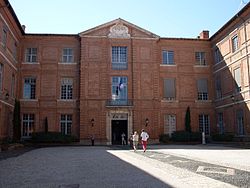Haute Garonne
| Haute-Garonne | ||
|---|---|---|
| Department | ||

Prefecture building of the Haute-Garonne department, in Toulouse
|
||
|
||
 Location of Haute-Garonne in France |
||
| Coordinates: 43°25′N 1°30′E / 43.417°N 1.500°ECoordinates: 43°25′N 1°30′E / 43.417°N 1.500°E | ||
| Country | France | |
| Region | Occitanie | |
| Prefecture | Toulouse | |
| Subprefectures |
Saint-Gaudens Muret |
|
| Government | ||
| • President of the General Council | Georges Meric | |
| Area | ||
| • Total | 6,309 km2 (2,436 sq mi) | |
| Population (2014) | ||
| • Total | 1,317,668 | |
| • Rank | 13th | |
| • Density | 210/km2 (540/sq mi) | |
| Time zone | CET (UTC+1) | |
| • Summer (DST) | CEST (UTC+2) | |
| Department number | 31 | |
| Arrondissements | 3 | |
| Cantons | 27 | |
| Communes | 588 | |
| ^1 French Land Register data, which exclude estuaries, and lakes, ponds, and glaciers larger than 1 km2 | ||
Haute-Garonne (French pronunciation: [ot ɡaʁɔn]; Occitan: Nauta Garona; English: Upper Garonne) is a department in the southwest of France named after the Garonne river. Its main city and capital is Toulouse.
Haute-Garonne is one of the original 83 departments created during the French Revolution on 4 March 1790. It was created from part of the former province of Languedoc.
The department was originally larger. The reduction in its area resulted from an imperial decree dated 21 November 1808 and which established the neighbouring department of Tarn-et-Garonne, to the north. The new department, created in response to the pleadings of various locally powerful politicians, took territory from five surrounding departments including Haute-Garonne. The districts lost to Tarn-et-Garonne in 1808 were those of Montech and Castelsarrasin.
Haute-Garonne is part of the current region of Occitanie and is surrounded by the departments of Hautes-Pyrénées, Gers, Tarn-et-Garonne, Tarn, Aude, and Ariège. It also borders Spain in the south (province of Lleida and province of Huesca).
...
Wikipedia

